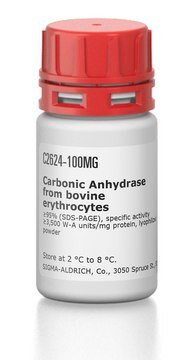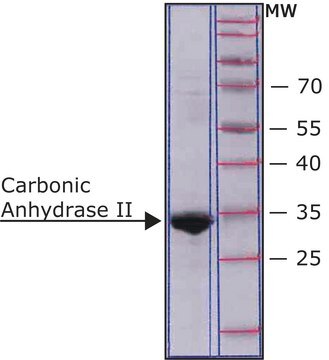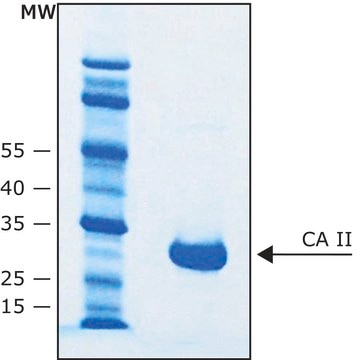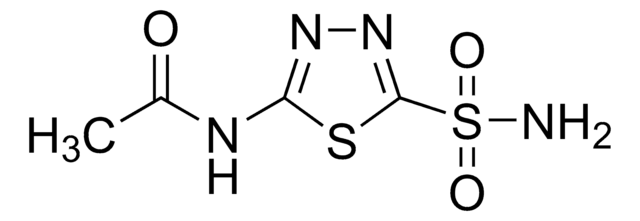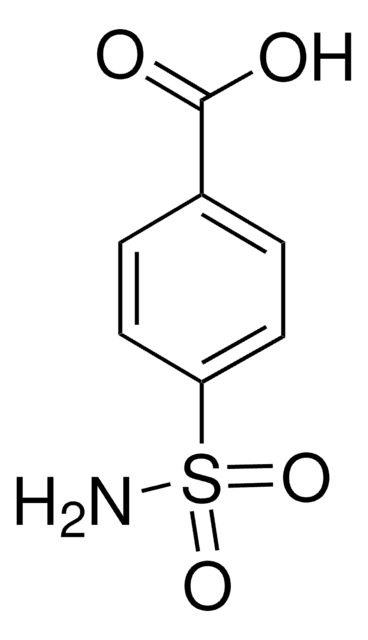C3640
Carbonic Anhydrase Isozyme II from bovine erythrocytes
lyophilized powder, ≥2,000 W-A units/mg protein
Synonym(s):
Carbonate Dehydratase, Carbonate Hydrolyase, Carbonic Anhydrase II
Sign Into View Organizational & Contract Pricing
All Photos(1)
About This Item
Recommended Products
form
lyophilized powder
Quality Level
specific activity
≥2,000 W-A units/mg protein
pI
~5.4
storage temp.
−20°C
Looking for similar products? Visit Product Comparison Guide
Application
Carbonic anhydrase from sigma has been used for the analysis of thermodynamic stability of the enzyme. The enzyme has also been used to generate CD4+ T cell lines specific for carbonic anhydrase during the study of autoimmune pancreatitis in rat.
Biochem/physiol Actions
Carbonic anhydrase is a zinc metalloenzyme that has a molecular weight of approximately 30,000 Da. The enzyme catalyzes the hydration of carbon dioxide to carbonic acid. It is involved in vital physiological and pathological processes such as pH and CO2 homeostasis, transport of bicarbonate and CO2, biosynthetic reactions, bone resorption, calcification, and tumorigenicity. Therefore, this enzyme is an important target for inhibitors with clinical applications in pathologies such as glaucoma, epilepsy and Parkinson′s disease.
Unit Definition
One Wilbur-Anderson (W-A) unit will cause the pH of a 0.02 M Trizma buffer to drop from 8.3 to 6.3 per min at 0 °C. (One W-A unit is essentially equivalent to one Roughton-Booth unit.)
inhibitor
Product No.
Description
Pricing
signalword
Danger
hcodes
pcodes
Hazard Classifications
Resp. Sens. 1
Storage Class
11 - Combustible Solids
wgk_germany
WGK 3
flash_point_f
Not applicable
flash_point_c
Not applicable
ppe
Eyeshields, Gloves, type N95 (US)
Certificates of Analysis (COA)
Search for Certificates of Analysis (COA) by entering the products Lot/Batch Number. Lot and Batch Numbers can be found on a product’s label following the words ‘Lot’ or ‘Batch’.
Already Own This Product?
Find documentation for the products that you have recently purchased in the Document Library.
Customers Also Viewed
Todd S Davidson et al.
The American journal of pathology, 166(3), 729-736 (2005-03-04)
Autoimmune pancreatitis (AIP), a recently defined disease of unknown etiology, is characterized by inflammatory infiltrates in the pancreas with conspicuous involvement of the ducts. The disease clinically manifests in humans as epigastric pain, weight loss, and jaundice. This report describes
Daumantas Matulis et al.
Biochemistry, 44(13), 5258-5266 (2005-03-30)
ThermoFluor (a miniaturized high-throughput protein stability assay) was used to analyze the linkage between protein thermal stability and ligand binding. Equilibrium binding ligands increase protein thermal stability by an amount proportional to the concentration and affinity of the ligand. Binding
Xiuhong Shan et al.
Journal of computer assisted tomography, 37(1), 22-28 (2013-01-17)
The objective of this study was to investigate the correlation between the degree of necrosis displayed in computed tomography (CT) image and the expression of hypoxic and angiogenesis biomarkers of breast cancer. Forty-four breast cancer cases were examined with CT
Bernardo V Alvarez et al.
BMC cardiovascular disorders, 13, 2-2 (2013-01-10)
Carbonic anhydrase enzymes (CA) catalyze the reversible hydration of carbon dioxide to bicarbonate in mammalian cells. Trans-membrane transport of CA-produced bicarbonate contributes significantly to cellular pH regulation. A body of evidence implicates pH-regulatory processes in the hypertrophic growth pathway characteristic
Laurie C Hofmann et al.
Journal of experimental botany, 64(4), 899-908 (2013-01-15)
The concentration of CO(2) in global surface ocean waters is increasing due to rising atmospheric CO(2) emissions, resulting in lower pH and a lower saturation state of carbonate ions. Such changes in seawater chemistry are expected to impact calcification in
Our team of scientists has experience in all areas of research including Life Science, Material Science, Chemical Synthesis, Chromatography, Analytical and many others.
Contact Technical Service

